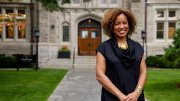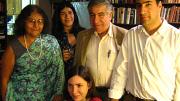On a warm November evening, more than a decade after a study committee first envisioned it, the completed Center for Government and International Studies (CGIS) was finally dedicated. Housed primarily in two new glass-and-terra-cotta buildings facing each other across Cambridge Street, CGIS “started out as something vastly different in size, scope and—let it be said—cost, from what we are gathered to celebrate today,” said President Lawrence H. Summers. (The final cost of the 249,000-square-foot complex reportedly exceeded $140 million.) “It has developed into a complex of buildings designed, redesigned, and redesigned by Harry Cobb and his associates; not without advice and involvement of the residents of the city of Cambridge, not without a certain amount of dust and heat in getting it built,” he noted wryly. Summers praised principal donor Sidney R. Knafel ’52, M.B.A. ’54, for remaining “deeply committed and yet flexible” through it all, and for “providing a wonderful example of how a true philanthropist best comports him- or herself as an institution works toward achieving an important goal.”
 |
| The Knafel Building of the new Center for Government and International Studies, home to the Faculty of Arts and Sciences' government department and several centers for international and regional studies |
Knafel, for whom the north building is named, spoke of his hopes for the center. “Relationships throughout the world over this past decade [have] continually eroded,” he said. “The social and political worlds are polarized as never before. Our own American society has become polarized as never before. Must we escape from this downdraft by military action in the world and a peaceful equivalent of war within the country?” He continued, “I say no because that process—military action—just does not work. Even when opponents are seen not to understand, we must engage them and their constituencies in dialogue based on understanding. The work to be done at this center,” he said hopefully, “will provide that understanding.”





